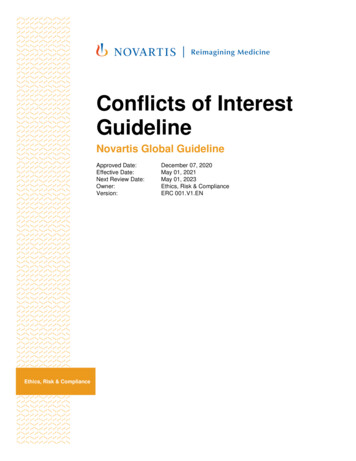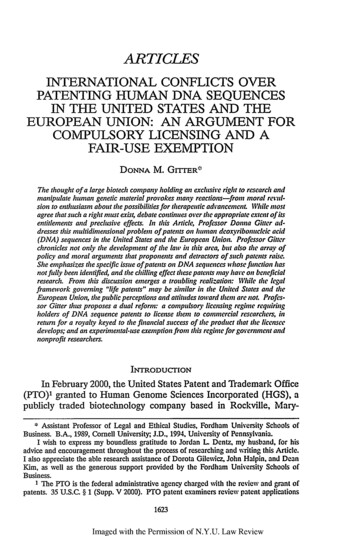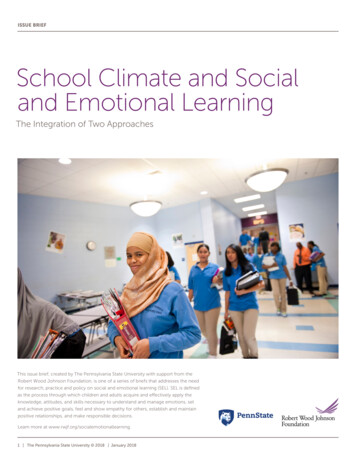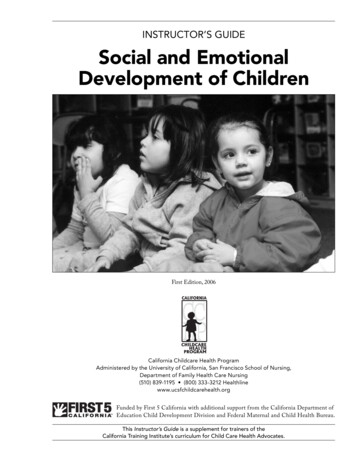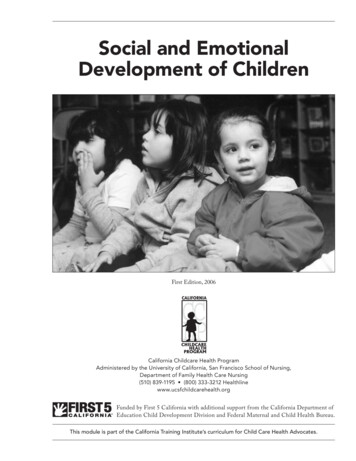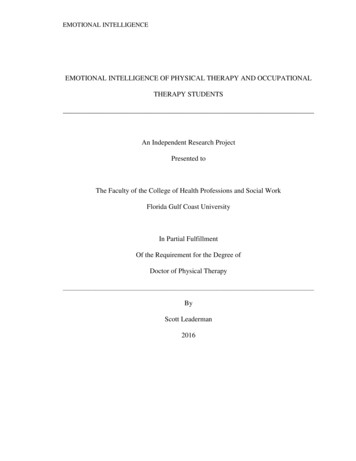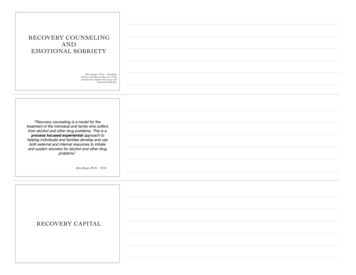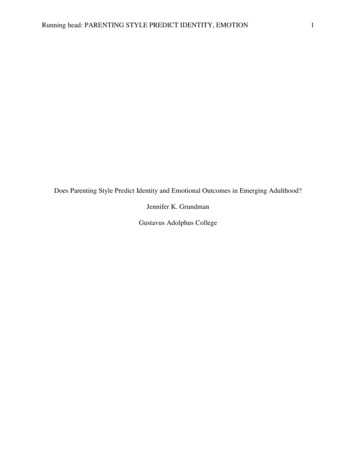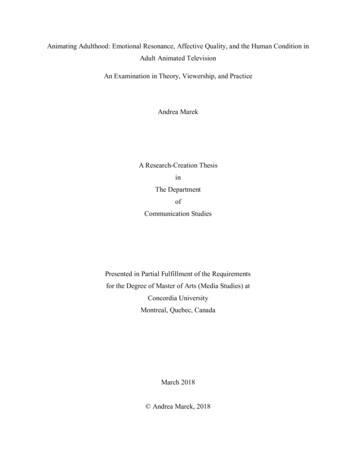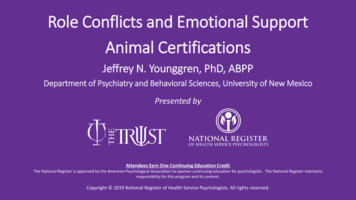
Transcription
Role Conflicts and Emotional SupportAnimal CertificationsJeffrey N. Younggren, PhD, ABPPDepartment of Psychiatry and Behavioral Sciences, University of New MexicoPresented byAttendees Earn One Continuing Education CreditThe National Register is approved by the American Psychological Association to sponsor continuing education for psychologists. The National Register maintainsresponsibility for this program and its content.Copyright 2019 National Register of Health Service Psychologists. All rights reserved.
Jeffrey N. Younggren, PhD, ABPPA Fellow of the American Psychological Association (APA) and a DistinguishedMember of the National Academies of Practice (NAP), Dr. Younggren is aclinical and forensic psychologist who practices in Albuquerque, New Mexicoand Rolling Hills Estates, California. He was a clinical professor at theUniversity of California, Los Angeles, School of Medicine and currently is aclinical professor in the Department of Psychiatry and Behavioral Sciences atthe University of New Mexico. Dr. Younggren has served on numerous boardsand committees, including the Ethics Committees of the CaliforniaPsychological Association (CPA) and the APA, the APA Committee onAccreditation, and the APA/APLS Committee that drafted the SpecialtyGuidelines for Forensic Psychology. Dr. Younggren consults to variouslicensing boards on ethics and standards of care, and qualifies as an expert incriminal, civil and administrative proceedings. For many years beforedeciding to travel less, he was a favored ethics presenter for The TrustProfessional Liability Insurance Program for Psychologists and continues toprovide consultation services for The Trust.
Disclosures/Conflicts of InterestThe presenter does not have any conflicts of interest to disclose.NOTE: The information presented in this webinar is not intendedto provide legal advice or to substitute for the advice of anattorney, but rather to provide information about considerationswhen dealing with requests for ESA certifications.
Disclaimer:This has nothing to do with liking ornot liking animals
Learning Objectives1. Describe the role conflicts that are created when a treating psychologistwrites an ESA certification letter for a current patient/client.2. Discuss what the law says about what ESAs can do and what they cannotdo.3. Identify ethically what should be considered when making an ESAdetermination.4. Identify what should be evaluated as part of an adequate ESA needsassessment.5. Analyze how the current disability laws impact ESA certification and thepotential long-term impact of this type of certification.
What is a Service Animal (SA)? The Americans with Disabilities Act (ADA)definition of a Service Animal (SA): Limited to dogs or miniature horses. A dog or miniature horse that is individually trained to perform tasksfor the benefit of an individual with a disability. Tasks a dog or miniature horse has been trained to provide must bedirectly related to the person’s disability (ADA, 2011).
What is an Emotional Support Animal (ESA)? ESAs can be pets. Special accommodations must be afforded to individualswho need ESAs to assist them psychologically. ESAs do not require the training that is necessary to certifyan animal as an ADA-compliant SA. For example, with proper documentation ESAs can be kept in housing thatprohibits pets. While this documentation does not allow the ESA accesseverywhere, it does require waiving a no-pet rule and also any relateddamage deposit.
ESAs in Action
Emotional Support Animals and Housing Housing that prohibits pets must allow ESAs, resultingin the waiving of a no-pet rule and any relateddamage deposit. Under the Fair Housing Act (FHA, 1968), an ESA isviewed as a reasonable accommodation in a housingunit that has a no pets rule. The imposition of a fee or deposit is consideredcontrary to the purpose of the law.
Emotional Support Animals and Air Travel The Air Carrier Access Act (ACAA, 2003) requires airlines to allow SAsand ESAs to accompany their handlers in the main cabin. Air carriers “shall not impose charges for providing facilities,equipment, or services that are required by this part [of the Act] tobe provided to qualified individuals with a disability” (FederalRegister, 2003). According to the Department of Transportation (DOT), passengerswith a mental health disability can travel with their animal in themain cabin of an airplane if that animal is an emotional supportanimal (ESA).
Emotional Support Animals and Air Travel Passengers who have a disability may have to provide the airline withcurrent documentation on the letterhead of a licensed mental healthprofessional stating:(a) the passenger has a mental health-related disability listed in the DSM–IV;(b) having the animal accompany the passenger is necessary to the passenger’smental health, treatment, or to assist the passenger;(c) the individual providing the assessment of the passenger is a licensedmental health professional and the passenger is under their professionalcare;(d) the date, type of the professional license, and the state or jurisdiction inwhich it was issued.(Federal Register, 2003)
Problems with Providing ESALetters to Patients Therapists have potential professional conflicts with dual roles. Letters are formal determinations/statements of a mentalhealth disability. The presence of the animal must ameliorate the defineddisability: Little empirical support in literature.Liking the animal around is not the amelioration of anything. Definitions of disability are quite varied. Presence of animal usually has nothing to do with therapy.
What is a Disability, Anyway?Richard Hunt, Esq.National PsychologistJanuary 2017 Disability is a legal concept. It is based upon six federal laws that have differing definitions. Consequently, for a mental health professional working with apatient, disability is not just a matter of discomfort, but apsychological disorder or problem that interferes with the patient’sability to perform major life activities. Disability means “a physical or mental impairment that substantiallylimits one of major life activities.” (Note the word substantially in the definition.)
Richard Hunt, Esq. “ even with emotional support animals there must be a “disabilityrelated need” for the animal a patient with mild depression may feelbetter when a pet cat is around this does not mean there is adisability related need for the animal.” Mental health professionals need to be aware that certifying a patientis disabled requires a proper medical diagnosis and the application ofthe correct legal definition of disability. Otherwise the certificationmay simply be wrong and may lead to legal action.
The ESA Industry
Certification of ESAs
Who is Evaluating the Need For and CertifyingEmotional Support Animals? Sampled 87 mental health practitioners who worked in a forensic orcombined forensic/clinical (57.5%); or clinical (42.5%) practice. Participants instructed to read the DOT description and indicatewhich tools/techniques they would use to arrive at a conclusion orrecommendation for the need for an ESA. Participants were also asked a series of questions about:1. Whether they have made a recommendation,2. Whether they believe it is appropriate for treating mental healthprofessionals to offer opinions on the need for an ESA, and3. Whether they feel competent to provide such determinations.
Logistic Regression Comparisons for ESA RecommendationInstruments/Techniques Across Types of PracticeForensic(% endorsed;n 50)Clinical(% endorsed;n 37)Total(% endorsed;n 87)Odds Ratio forForensic vs.ClinicalSymptom Checklist30.682.952.411.0**Brief Symptom Inventory22.945.732.52.8*Malingering Assessment70.840.057.80.3**PAI or MMPI83.344.466.70.2**InstrumentNote. *p .05 **p .01.
Logistic Regression Comparisons for ESA RecommendationsAcross Types of PracticeForensicClinicalTotalOdds Ratio(% endorsed; (% endorsed; (% endorsed; for Forensicn 50)n 37)n 87)vs. ClinicalHas made an ESArecommendation for one ormore individuals18.050.031.44.6*Believes it is appropriate for atreating mental healthprofessional to offer an opinionon the need for an ESA77.180.678.61.265.362.364.30.9Feels qualified to make an ESAdeterminationNote. * p .01.
Summary of Results Forensic practitioners chose more complex and forensicallyvalid instruments (e.g. MMPI, malingering). Clinical practitioners make more recommendations, BUTmany forensic practitioners believe it is appropriate fortreating professionals to make recommendations. Clarify WHO should be making these evaluations and HOW 64% feel competent to conduct ESA assessments despite lackof guidelines.
Ethical Issues and Concerns Role conflicts Competence Risk to the therapeutic alliance Objectivity Thoroughness Vicarious liability
Alaska Airlines ESA Attack
Recommended Evaluation Model Younggren, Boness, Bryant and Koocher (submitted) A formal disability evaluation consistent with legaldefinitions of disability. A thorough understanding of the laws that impact ESAs. An evaluation of the animals ability to perform thefunction consistent with the animals abilities andtemperament. An evaluation of the interaction of the animal with theowner to support claim of amelioration.
References Younggren, J. N., Boisvert, J. and Boness, C. (2016), ExaminingEmotional Support Animals and Role Conflicts in ProfessionalPsychology, Professional Psychology: Research and Practice, Vol 47(4),Aug 2016, 255-260. Boness, C.L., Younggren, J.N. and Frumkin, B. (2017). The certificationof emotional support animals: Differences between clinical andforensic mental health practitioners, Professional Psychology:Research and Practice, Vol 48(3), Jun 2017, 216-221,http://dx.doi.org/10.1037/pro0000147.
Questions?
Sampled 87 mental health practitioners who worked in a forensic or combined forensic/clinical (57.5%); or clinical (42.5%) practice. Participants instructed to read the DOT description and indicate which tools/techniques they would use to arrive at a conclusion or recommendation for the need for an ESA.

